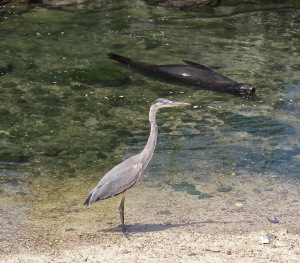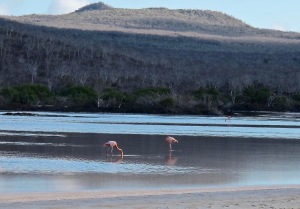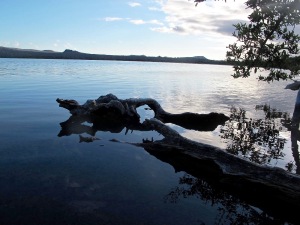Española is the southern-most island in the Galápagos and is the only breeding site in the world for the Waved Albatross.
Although I didn’t see any giant tortoises on Española, there are many. In the 1960s only 14 Española giant tortoises were living on the island. Thanks to breeding efforts at the Charles Darwin Station, more than 2,000 have been released and the species is once again thriving. I vaguely recollect that Super Diego might have had something to do with that.
Our first exploration of the day was at Suarez Point that involved a hike to see the Waved Albatross. I was excited to see them up close and personal! As we neared our landing spot, we were greeted by several sea lion pups playing in the water and LOUD barks from a big alpha sea lion. Erick told us the sea lion mamas were out fishing and the bull was a babysitter. He was making sure no one (animal or human) got out of line. Believe me, we didn’t want to mess with him.
Once we landed, we almost immediately saw a mess (term for a group) of marine iguanas. They were busy getting warmed up enough to go swimming to eat their lunch. It takes them several hours to get warm enough and then can only last about 15 minutes per swimming session. The red on their hides is left over from the mating season. Some were redder than others. Note the lava lizard on the post. To the right of the white post is our path to the albatross nests, thus forcing us to break the rule of staying several feet from each animal. We just watched our step and walked right by them. They didn’t flinch.
As we walked farther into the trail, we continued to see many marine iguanas and lava lizards. We watch one lava lizard try to court a female. He would do his push ups (as we might have seen lizards in our area do). The female would kind of dance around as I remember and then he’d do some more advancing. But after a bit, the female walked away. He looked dejected but perhaps he because his tail was short. Perhaps he lost it in a fight or maybe a bird tried to get him.

Speaking of birds, we saw the Española mockingbird with his curved beak. He, too, was as curious as the Galápagos mocker we had seen on other islands. He would walk right up to us trying to check out our gear.
Soon we left the easy sand and began to walk on a pretty rough path. We all had to watch our step…for more than one reason. A marine iguana and a seal lion were on the path each doing it’s own thing.
It didn’t take long before we were seeing birds all over the place.
This magnificent blowhole might be the tallest one I’ve ever seen. But, then, it was difficult to get a perspective of size because we were looking down on it. The red spots around the blowhole were Sally Lightfoot crabs. I wonder how often they crawl too far down the blowhole and get blown up in the sky.

We walked a bit farther and saw albatross and their chick. What a great sight! The chicks aren’t very cute but they do grow up to be beautiful birds.

Right in the midst of all the albatross was a marine iguana high on a bluff. I wondered why he was so high above the surf line. Shirley and I took advantage and had our portrait taken with him.
We were privileged to see two pairs of albatross do their mating dance and even though I felt like I was intruding, I took some photos of them. This dance is quite elaborate and these are just four steps to it. I was quite impressed to watch it but I don’t know the outcome. Did she or did she not accept?

On the way back to our Zodiac, I took this picture of the “Creature from the Black Lagoon.” Note how sort of smushed its face is. This is an adaptation that allows the iguana to crop the algae even closer to the rock.
We left Suarez Point and sailed to Gardiner Bay, on the eastern side of the island. This was our last chance to snorkel and see some fun animals. Pato took us into a cove where we were greatly entertained by sea lion pups. They were learning how to fish were often successful. One guy would take his catch up on the rocks and proceed to whack the poor fish on the rocks. Then he would eat it. Perhaps he was tenderizing it. Who knows?
You might be wondering why we wore wetsuits when we were so near the equator the entire time. A good question. We learned that cold, strong currents from Antarctica were flowing into the area and meeting northern currents. This caused a welling of particles in the ocean that brings fish and birds. That is one reason why the Islands teem with birds and fish. Genovesa was relatively warm but Española was a lot colder. That blotchy white thing in the left side of the rocks is a pup beaching himself.
After our adventure with the sea lions, we had some time on Gardiner Bay beach and then we boarded the Galaven to head toward San Cristobal.
We discovered we had some hitchhikers on our voyage to San Crisotbal.
Throughout the voyage, all of us who lived below the main deck would go up and down these steep stairs. If you went down straight, your calves soon became bruised from banging on the narrow steps. I ended up going down sideways quite often to avoid those bruises.
 We woke up the next morning in Puerto Basquerizo Moreno on the Island of San Cristobal. We ate our last breakfast aboard the Galaven and left our gear for the crew to take to the airport. We all went to the Interpretation Center where we enjoyed expositions on natural history, human history and conservation. We had been hearing about conservation the entire trip, as it is so important to protect the wildlife and natural environment on the Islands.
We woke up the next morning in Puerto Basquerizo Moreno on the Island of San Cristobal. We ate our last breakfast aboard the Galaven and left our gear for the crew to take to the airport. We all went to the Interpretation Center where we enjoyed expositions on natural history, human history and conservation. We had been hearing about conservation the entire trip, as it is so important to protect the wildlife and natural environment on the Islands.
That afternoon, we took off from San Cristobal and flew to Quito to spend the night. We rose again at the ungodly hour of 2:15 to get our bus back to the airport to get ready for the flight from Quito to Miami. It was a very long day that didn’t end until midnight at Shirley’s place in Grand Junction. But it was worth it! I loved the trip and would do it again.
I want to thank Julia, our mighty tour leader, who provided us with some great handouts and clues about the trip. I have shamelessly plagiarized from those notes to give some of the historical perspective. Julia organized a great trip and we all benefited from her research and preparation.
SOME OUTAKES





































































